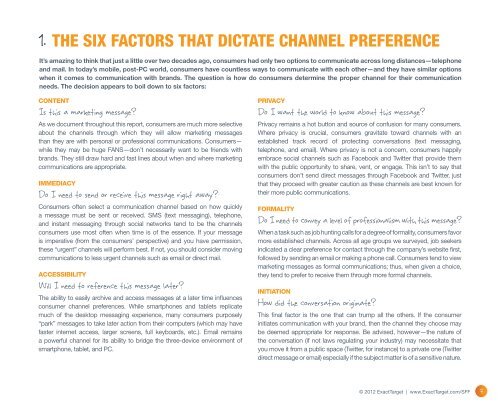The 2012 Channel Preference Survey (PDF) - Prisa Digital
The 2012 Channel Preference Survey (PDF) - Prisa Digital
The 2012 Channel Preference Survey (PDF) - Prisa Digital
You also want an ePaper? Increase the reach of your titles
YUMPU automatically turns print PDFs into web optimized ePapers that Google loves.
1.<br />
ThE SIX FACTORS ThAT DICTATE ChANNEL PREFERENCE<br />
It’s amazing to think that just a little over two decades ago, consumers had only two options to communicate across long distances—telephone<br />
and mail. In today’s mobile, post-PC world, consumers have countless ways to communicate with each other—and they have similar options<br />
when it comes to communication with brands. <strong>The</strong> question is how do consumers determine the proper channel for their communication<br />
needs. <strong>The</strong> decision appears to boil down to six factors:<br />
CONTENT<br />
Is this a marketing message?<br />
As we document throughout this report, consumers are much more selective<br />
about the channels through which they will allow marketing messages<br />
than they are with personal or professional communications. Consumers—<br />
while they may be huge FANS—don’t necessarily want to be friends with<br />
brands. <strong>The</strong>y still draw hard and fast lines about when and where marketing<br />
communications are appropriate.<br />
IMMEDIACY<br />
Do I need to send or receive this message right away?<br />
Consumers often select a communication channel based on how quickly<br />
a message must be sent or received. SMS (text messaging), telephone,<br />
and instant messaging through social networks tend to be the channels<br />
consumers use most often when time is of the essence. If your message<br />
is imperative (from the consumers’ perspective) and you have permission,<br />
these “urgent” channels will perform best. If not, you should consider moving<br />
communications to less urgent channels such as email or direct mail.<br />
ACCESSIBILITY<br />
Will I need to reference this message later?<br />
<strong>The</strong> ability to easily archive and access messages at a later time influences<br />
consumer channel preferences. While smartphones and tablets replicate<br />
much of the desktop messaging experience, many consumers purposely<br />
“park” messages to take later action from their computers (which may have<br />
faster internet access, larger screens, full keyboards, etc.). Email remains<br />
a powerful channel for its ability to bridge the three-device environment of<br />
smartphone, tablet, and PC.<br />
PRIVACY<br />
Do I want the world to know about this message?<br />
Privacy remains a hot button and source of confusion for many consumers.<br />
Where privacy is crucial, consumers gravitate toward channels with an<br />
established track record of protecting conversations (text messaging,<br />
telephone, and email). Where privacy is not a concern, consumers happily<br />
embrace social channels such as Facebook and Twitter that provide them<br />
with the public opportunity to share, vent, or engage. This isn’t to say that<br />
consumers don’t send direct messages through Facebook and Twitter, just<br />
that they proceed with greater caution as these channels are best known for<br />
their more public communications.<br />
FORMALITY<br />
Do I need to convey a level of professionalism with this message?<br />
When a task such as job hunting calls for a degree of formality, consumers favor<br />
more established channels. Across all age groups we surveyed, job seekers<br />
indicated a clear preference for contact through the company’s website first,<br />
followed by sending an email or making a phone call. Consumers tend to view<br />
marketing messages as formal communications; thus, when given a choice,<br />
they tend to prefer to receive them through more formal channels.<br />
INITIATION<br />
How did the conversation originate?<br />
This final factor is the one that can trump all the others. If the consumer<br />
initiates communication with your brand, then the channel they choose may<br />
be deemed appropriate for response. Be advised, however—the nature of<br />
the conversation (if not laws regulating your industry) may necessitate that<br />
you move it from a public space (Twitter, for instance) to a private one (Twitter<br />
direct message or email) especially if the subject matter is of a sensitive nature.<br />
© <strong>2012</strong> ExactTarget | www.ExactTarget.com/SFF<br />
7

















